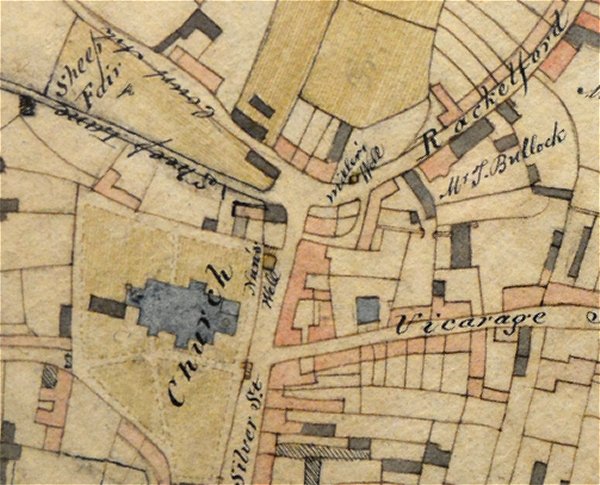nuns' well
nuns' well
Silver Street
Nuns' Well, sometimes called Stairs Well, was a public well (Yeovil didn’t have mains water until the middle of the nineteenth century) in Silver Street, on the west side between the steps to Church Terrace and North Lane. It was most likely named for the nuns of the Convent of Syon, in Middlesex, who held the lordship and rectory of Yeovil from 1450 until the Dissolution, between 1536 and 1541. Nuns' Well was in the manor of Hendford while Miller's Well, just yards away, was in the manor of Kingston.
The well is mentioned in the Churchwarden’s Accounts when it was repaired in 1568 with "a Post to bear the railes of Nun Well and a Staple and nails for the same" which cost a shilling and in the same year it was recorded that John Belk mended the gutter of the well and "made it new."
In his will of 24 August 1580, woollen draper Gyles Hayne wrote "... Also I geve, will, and devise unto my saide Sonne Josephe One tenemente or Burgage w[i]th his Appurtenannces over againste Nunwell within the Borowe of yeavell foresaide ...".
John Day was paid two shillings "for ye Rayles at Nunwell" in 1717 and it was repaired again in 1733 when a combined payment of six shillings was "Paid for Postes and Railes for Nun Well and Bellfree Door."
An indenture of 1751 refers to properties "adjoining to a well called Nune Well late in the tenure of John Day." and Vickery noted that repairs to Nuns' Well was the responsibility of the Portreeve and Burgesses.
That the Nuns Well was fenced in and had a gate is verified in an entry in the Churchwardens' accounts of 1805 when they paid £1 12s 0d to local builder Thomas Churchouse "for 4 Oak Posts against Nuns Well & Morticed" plus 9s 11d for "Mr Churchouse's Bill on for Ditto 34 feet Oak Rails @ 3½" and 9s 6d for "Ditto An Oak Gate to the same by Nuns Wells" with 5s 0d for "Labour about the same".
E Watts' 1806 map of Yeovil, shown below, locates Nuns' Well where the steps of today's Church Terrace join Silver Street.
In 1852 in his Report to the General Board of Health concerning, among other items, Yeovil's water supply, Thomas Rammell wrote "The well or spring in Reckleford (Miller's Well), gives a small supply of very pure water. It finds its way from under the side of the rock, or limestone strata. The well at the Church Steps (Nuns' Well) is under similar circumstances, that is, the water finds a passage between the rock and the compact indurated clay, marl, etc. immediately beneath it."
In 1851 there were one hundred and thirteen wells and pumps in Yeovil. Other than Nuns' Well, the principal wells of the town were Dick's Well and Rustywell, both in Hendford, Miller's Well in Market Street, Bide's Well in Kingston, Cave's Well in Princes Street, Turner's Well and Hannam's Well both in High Street, and the Gasworks Well. But, to quote Vickery "Several wells in the town are contaminated by the soakage from private sewers, deposit of offal, refuse of skins, and other filth."
In earlier times, maintenance of the town's wells was often paid for by donations from the townspeople. For example, in Alice Lane's will of 1655 she wrote "Item I give towards the repairings of the Well in Kingeston five pounds which doth lye in John Moores hands".
map

E Watts' map of 1806 showing the location of Nuns' Well at centre and Miller's Well above and to its right. Note that the buildings on the corner of Silver Street and Sheep Lane (today's North Street) are not Church Terrace which was built later.